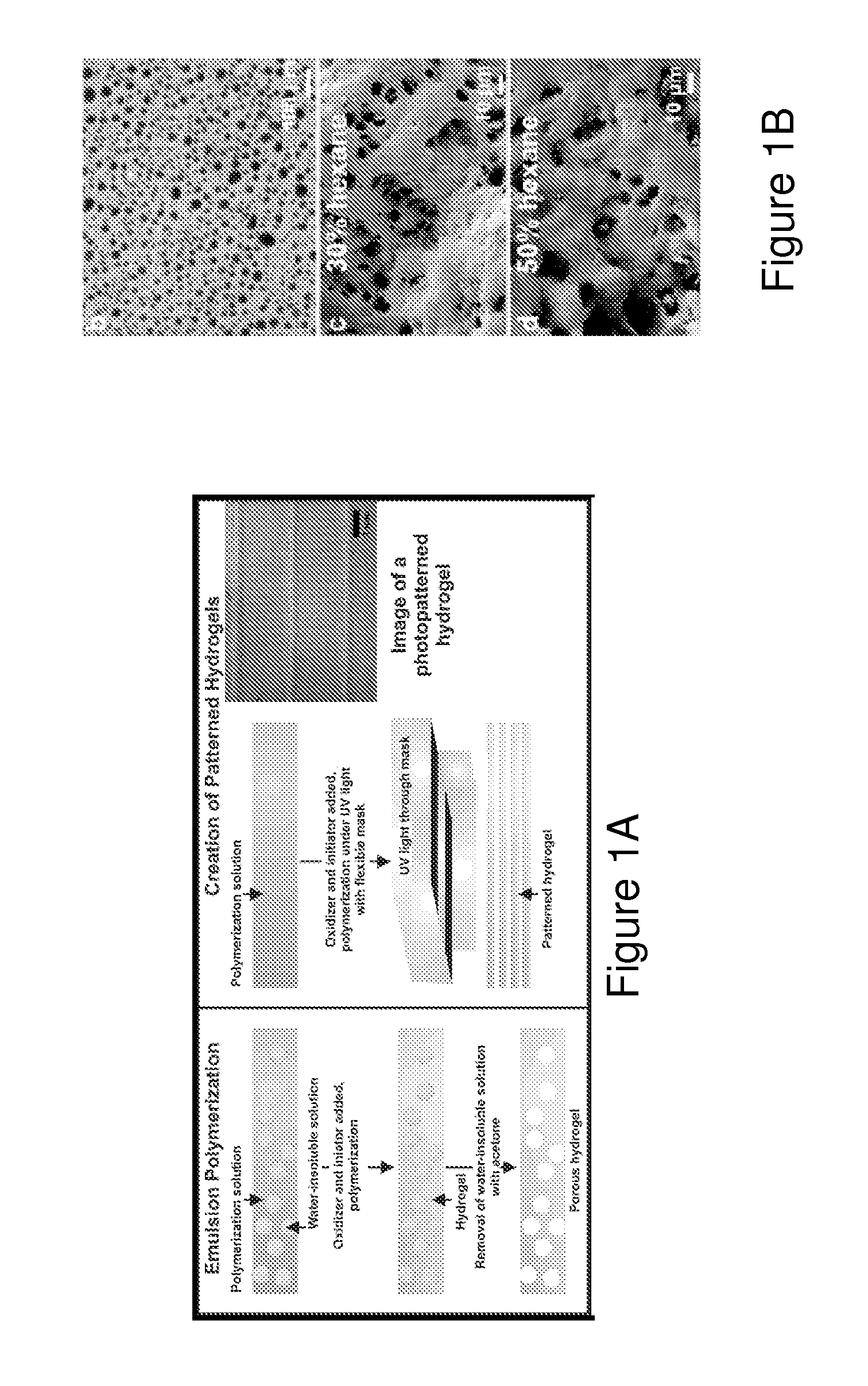Porous electroactive hydrogels and uses thereof
a technology of electroactive hydrogels and electroactive hydrogels, which is applied in the field of porous electroactive hydrogels, can solve the problems of not being able to contribute to the permanent network elasticity, chemical hydrogels are not homogeneous, and chain loops and free chain ends also produce network defects in both physical and physical, so as to achieve fast contractility, maximize electroactuation, and be able to bend more easily
- Summary
- Abstract
- Description
- Claims
- Application Information
AI Technical Summary
Benefits of technology
Problems solved by technology
Method used
Image
Examples
example 1
Preparation and Actuation of Porous Electroactive Hydrogels
[0107]In order to optimize the electroactive hydrogel bending, an emulsion templating technique was employed to increase the hydrogel porosity (FIG. 1). The size of pores primarily depended on the volume fraction of the oil phase (hexane) utilized and the concentration of surfactant (Tween 20) added. Employing the emulsion templating method, a polydisperse distribution of pore sizes was generated, with the diameter of the smallest pores being ˜10 μm (FIG. 1c, d). By creating porous hydrogels using emulsion templating, bending angles of 70-90° were achieved with 2.5 V / cm electric field applied for 3 minutes (FIG. 4). This result represents a substantial improvement over previous studies where maximum bending angles of −30° to −40° (towards the cathode) were achieved when the electroactive hydrogels with the same dimensions were placed in 1.5 V / cm electric fields for 2 minutes (Moschou, E. A. et al. (2004) Chem. Mater. 16, 249...
example 2
Effects of a Spatiotemporal pH Gradient on Porous Electroactive Hydrogel Bending
[0110]In this experiment, the effect of the spatiotemporal pH gradient on hydrogel bending, as well as the mechanisms underlying large bending of porous PAANa hydrogels were determined. The timescale and magnitude of these pH gradients can explain why larger deformation of PAANa hydrogels occurs in stronger electric fields. As larger electric fields are applied, a steeper pH gradient was created across the hydrogel (FIG. 5b,c), thus yielding a spatial gradient of COOH and COO− groups within the hydrogel. As more COOH groups were created within the hydrogel on the anode side relative to the cathode side, the polymer compressed on the COOH dominant (anode) side, generating a large bending angle.
[0111]The process of PAANa hydrogel bending is illustrated schematically in FIG. 3, where the extent of ionic gradients in the gel (CGNa+, CG+) depend on the fixed concentration of negative charges in the gel. Befor...
example 3
Effects of Porous Electroactive Hydrogel Density and Elasticity on Bending
[0113]Overall, both porous and non-porous hydrogels bend in a similar manner due to ion diffusion when no strong pH gradient is present. However, once a pH gradient is present, porous hydrogels produce larger bending angles than non-porous hydrogels since porous gels are less dense, such that they require less deswelling and compression on the anode side of the gel to produce a bending motion. For instance, a porous gel will have more void space and less polymer material within the cross-sectional area of the gel. Since the porous gels have less polymer material within the cross-sectional area of the gel, a smaller concentration of COOH groups must be generated across the cross-sectional area of the gel to cause the porous polymer to compress. It was observed that 50% thinner, non-porous hydrogels follow the same bending trajectory as porous hydrogels. Thin, non-porous hydrogels are able to bend to the same ex...
PUM
| Property | Measurement | Unit |
|---|---|---|
| radius | aaaaa | aaaaa |
| electric field | aaaaa | aaaaa |
| angle | aaaaa | aaaaa |
Abstract
Description
Claims
Application Information
 Login to View More
Login to View More - R&D
- Intellectual Property
- Life Sciences
- Materials
- Tech Scout
- Unparalleled Data Quality
- Higher Quality Content
- 60% Fewer Hallucinations
Browse by: Latest US Patents, China's latest patents, Technical Efficacy Thesaurus, Application Domain, Technology Topic, Popular Technical Reports.
© 2025 PatSnap. All rights reserved.Legal|Privacy policy|Modern Slavery Act Transparency Statement|Sitemap|About US| Contact US: help@patsnap.com



